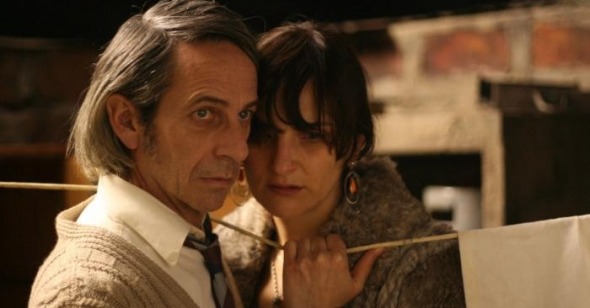Hollow Man
by Ela Bittencourt
Post Mortem
Dir. Pablo LarraĂn, Chile, Film Movement
Pablo LarraĂn’s Post Mortem pulsates with quiet, murderous passion. In it, the stone-faced yet irresistibly watchable Alfredo Castro is Mario, a middle-aged loner and coroner’s assistant obsessed with an anorexic cabaret dancer Nancy Puelma, played by Antonia Zegers. While visiting Nancy in her dressing room, Mario overhears the harangues of her manager and offers her a ride home, but his car is stalled by a political demonstration. LarraĂn frames the story by next showing Nancy’s naked body, mauve to the point of translucency, on a coroner’s table. Mario, in his role of assistant, registers the causes of her death as malnutrition and dehydration.
By revealing Nancy’s demise early on and telling her story in flashbacks, LarraĂn subtly blurs the line between reality and memory, showing Mario as a man haunted by his nation’s past, while remaining outside of its politics. What follows is a masterful recap: moments from Nancy and Mario’s awkward courtship alternate with scenes detailing the examination of cadavers. Mario’s job might seem prosaic, had the movie not been set in Chile in the 1970s—inspired by the real story of the autopsy of Chilean president Salvador Allende who, after his assassination in a coup of 1973, was replaced by the brutal dictator Augusto Pinochet. Some of the autopsy scenes were shot in the same hospital room where the corpse of Allende had been originally examined. Beyond the accuracy of locations, LarraĂn also evokes the past by using anamorphic Lomo lenses, made in Russia in the 60s and 70s that give the film a pale color palette of old, faded slides. The muted grays could be a metaphor for Mario himself, a lanky and shadowy everyman, who goes about his inconsequential existence until he falls for Nancy.
Post Mortem’s political terror builds slowly: the cause of one victim’s death is determined as having been savagely beaten but cannot be recorded; the chief doctor professes the rise of a “new man” with fascist piety, as Mario’s coworkers eat lunch in grim, catatonic silence. Throughout, Mario seems apathetic to his country’s future. He is a bit of a prig, lecturing his coworker Sandra about the dangers of sleeping with men, and emotionally thwarted, as if his soul were itself a morgue. LarraĂn clearly intends him to stand in for all those who witness political violence on a daily basis, taking it in as subconsciously as one does air.
Mario rarely betrays any emotion. In one surprising scene, however, we find him weeping inconsolably with Nancy. The cause for their sudden outburst is unclear—for Nancy, it might be her fading fame and looks; for Mario, a way to show empathy, or an inarticulate cry of alienation. By keeping the characters’ motivations vague, LarraĂn strengthens the film’s absurdist tone that only grows stronger as the grotesqueness of the country’s politics escalates. The tone also has a distancing effect: even though Mario has sex with Nancy, we can never take his passion seriously—or accept it as passion—since he seems both clinically repressed and out of touch with reality.
But reality creeps back in: during a raid on Nancy’s home, which has been used for clandestine political meetings, her father is arrested. The terror soon reaches Mario’s hospital, taken over by the military. In a particularly chilling scene, the soldiers carry in a body to be examined, but neither the nurse nor the doctor can bring themselves to cut it open: the deceased has been identified as Allende, and the military is there to make sure that his murder is falsified, as a suicide. Allende’s death serves as an invitation for the army to take vengeance on his sympathizers. Cadavers pile up, and those not yet dead are promptly finished off, making any resistance on the part of Mario or the nurses pointless. The grotesque mood is accentuated by Mario’s existential vacuity: unlike Sandra, his female colleague, he does not voice any protest against the army’s brutalities, obediently wheeling the heaps of human flesh down the hospital’s hallways, in scenes that evoke Hannah Arendt’s “banality of evil.” But in the end, the nation’s madness does spill into his own: in hiding, Nancy relies on Mario for protection. But when her activist-boyfriend shows up, Nancy coldly masturbates Mario, in return for favors. Unable to bear the humiliation, Mario blocks her shelter’s exit.
Post Mortem is only LarraĂn’s second feature, but he has already proven a distinct style—an unmistakable deadpan—and an interest in political and personal utopias. In his first film, Tony Manero, amateur dancer RaĂşl is so obsessed with John Travolta in Saturday Night Fever that he commits multiple murders and forsakes his family in order to adequately transform into him. In both films, political and personal extremes meet: Mario or RaĂşl’s unfeeling may be a result of the daily oppression they have internalized, but the characters’ psychological and moral apathy also enables the spread of violence. What makes LarraĂn’s antiheroes so beguiling is that they show no awareness of their monstrosity—they’re doomed to the purgatory of idiosyncratic delusions that mirror but ultimately transcend history.
